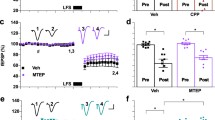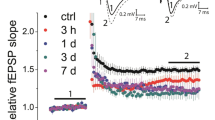Abstract
Acidic amino acids, such as L-glutamate, are believed to be excitatory neurotransmitters in the mammalian brain1,2 and exert effects on several different receptors named after the selective agonists kainate, quisqualate and N-methyl-D-aspartate (NMDA)1. The first two receptors, collectively termed non-NMDA receptors, have been implicated in the mediation of synaptic transmission in many excitatory pathways in the central nervous system (CNS), whereas NMDA receptors, with few exceptions, do not appear to be involved2; this is typified in the hippocampus where there is a high density of NMDA receptors3 yet selective NMDA receptor antagonists, such as D-2-amino-5-phosphonovalerate (APV), do not affect synaptic potentials4–11. NMDA receptors have, however, been shown to be involved in long-term potentiation (LTP) in the hippocampus6–11, a form of synaptic plasticity12 which may be involved in learning and memory11. NMDA receptors have also been found to contribute to epileptiform activity in this region13,14. We now describe how NMDA receptors can participate during high-frequency synaptic transmission in the hippocampus, their involvement during low-frequency transmission being greatly suppressed by Mg2+. A frequency-dependent alleviation of this blockade provides a novel synaptic mechanism whereby a single neurotransmitter can transmit very different information depending on the temporal nature of the input. This mechanism could account for the involvement of NMDA receptors in the initiation of LTP and their contribution, in part, to epileptic activity.
Similar content being viewed by others
References
Watkins, J. C. & Evans, R. H. A. Rev. Pharmac. Tox. 21, 165–204 (1981).
Watkins, J. C. Trends pharmac. Sci. 5, 373–376 (1984).
Olverman, H. J., Jones, A. W. & Watkins, J. C. Nature 307, 460–462 (1984).
Crunelli, V., Forda, S., Collingridge, G. L. & Kelly, J. S. Nature 300, 450–452 (1982).
Koerner, J. F. & Cotman, C. W. Brain Res. 251, 105–115 (1982).
Collingridge, G. L., Kehl, S. J. & McLennan, H. J. Physiol., Lond. 334, 33–46 (1983).
Collingridge, G. L., Kehl, S. J. & McLennan, H. J. Physiol., Lond. 338, 27P (1983).
Wigström, H. & Gustafsson, B. Neurosci. Lett. 44, 327–332 (1984).
Harris, E. W., Ganong, A. H. & Cotman, C. W. Brain Res. 323, 132–137 (1984).
Slater, N. T., Stelzer, A. & Galvan, M. Neurosci. Lett. 60, 25–31 (1985).
Morris, R. G. M., Anderson, E., Lynch, G. S. & Baudry, M. Nature 319, 774–776 (1986).
Bliss, T. V. P. & Lømo, T. J. Physiol., Lond. 232, 331–358 (1973).
Hynes, M. A. & Dingledine, R. Soc. Neurosci. Abstr. 10, 229 (1984).
Herron, C. E., Williamson, R. & Collingridge, G. L. Neurosci. Lett. 61, 255–260 (1985).
Collingridge, G. L., Kehl, S. J. & McLennan, H. J. Physiol., Lond. 334, 19–31 (1983).
Coan, E. J. & Collingridge, G. L. Neurosci. Lett. 53, 21–26 (1985).
Katz, B. & Miledi, R. J. Physiol., Lond. 168, 389–422 (1963).
Hille, B., Woodhull, A. M. & Shapiro, B. I. Phil. Trans. R. Soc. B 270, 301–318 (1975).
Hablitz, J. J. & Langmoen, I. A. J. Neurosci. 6, 102–106 (1986).
Collingridge, G. L. Trends pharmac. Sci. 6, 407–411 (1985).
Wigström, H., Gustafsson, B. & Huang, Y.-Y. Acta physiol. scand. 124, 474–478 (1985).
Dingledine, R. J. Physiol., Lond. 343, 385–405 (1983).
Heinemann, U., Hamon, B. & Konnerth, A. Neurosci. Lett. 47, 295–300 (1984).
Ascher, P. & Nowak, L. J. Physiol., Lond. (in the press).
MacDermott, A. B., Mayer, M. L., Westbrook, G. L., Smith, S. J. & Barker, J. L. Nature 321, 519–522 (1986).
Lynch, G., Larson, J., Kelso, S., Barrionuevo, G. & Schottler, F. Nature 305, 719–721 (1983).
Nowak, L., Bregestovski, P., Ascher, P., Herbet, A. & Prochiantz, A. Nature 307, 462–465 (1984).
Wigström, H., Gustafsson, B., Huang, Y.-Y. & Abrahams, W. C. Acta physiol. scand. 126, 317–319 (1986).
Croucher, M. J., Collins, J. F. & Meldrum, B. S. Science 216, 889–901 (1982).
Salt, T. E. Nature 322, 263–265 (1986).
Dale, N. & Roberts, A. J. Physiol., Lond. 348, 527–543 (1984).
Malinow, R. & Miller, J. P. Nature 320, 529–520 (1986).
Author information
Authors and Affiliations
Rights and permissions
About this article
Cite this article
Herron, C., Lester, R., Coan, E. et al. Frequency-dependent involvement of NMDA receptors in the hippocampus: a novel synaptic mechanism. Nature 322, 265–268 (1986). https://doi.org/10.1038/322265a0
Received:
Accepted:
Issue Date:
DOI: https://doi.org/10.1038/322265a0
- Springer Nature Limited
This article is cited by
-
Adenosine Signaling and Clathrin-Mediated Endocytosis of Glutamate AMPA Receptors in Delayed Hypoxic Injury in Rat Hippocampus: Role of Casein Kinase 2
Molecular Neurobiology (2021)
-
The 1980s: d-AP5, LTP and a Decade of NMDA Receptor Discoveries
Neurochemical Research (2019)
-
Differential modulation of NMDA and AMPA receptors by cellular prion protein and copper ions
Molecular Brain (2018)
-
Glutamate receptors function as scaffolds for the regulation of β-amyloid and cellular prion protein signaling complexes
Molecular Brain (2015)
-
MK-801 and amphetamine result in dissociable profiles of cognitive impairment in a rodent paired associates learning task with relevance for schizophrenia
Psychopharmacology (2015)





